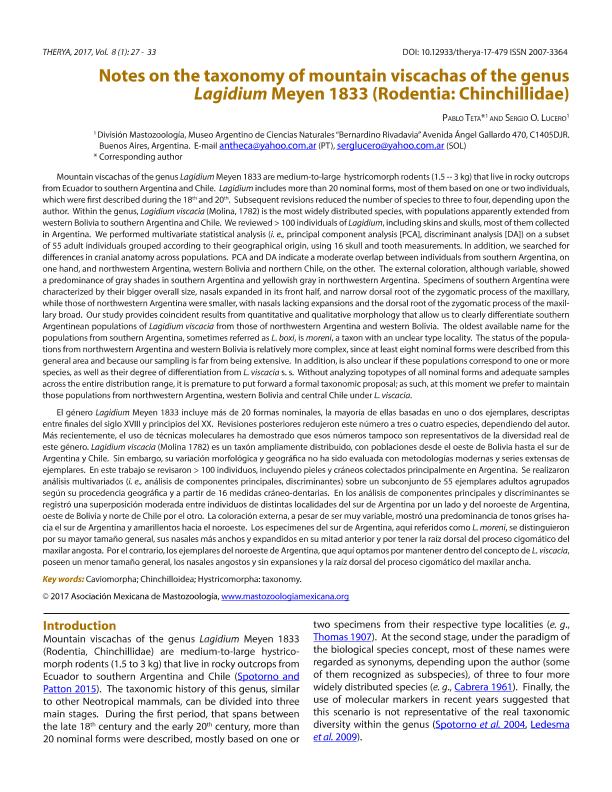Mostrar el registro sencillo del ítem
dc.contributor.author
Teta, Pablo Vicente

dc.contributor.author
Lucero, Sergio

dc.date.available
2018-06-12T16:07:07Z
dc.date.issued
2017-01
dc.identifier.citation
Teta, Pablo Vicente; Lucero, Sergio; Notes on the taxonomy of mountain viscachas of the genus Lagidium Meyen 1833 (Rodentia: Chinchillidae); Asociación Mexicana de Mastozoología; Therya; 8; 1; 1-2017; 27-33
dc.identifier.issn
2007-3364
dc.identifier.uri
http://hdl.handle.net/11336/48312
dc.description.abstract
El género Lagidium Meyen 1833 incluye más de 20 formas nominales, la mayoría de ellas basadas en uno o dos ejemplares, descriptas entre finales del siglo XVIII y principios del XX. Revisiones posteriores redujeron este número a tres o cuatro especies, dependiendo del autor. Más recientemente, el uso de técnicas moleculares ha demostrado que esos números tampoco son representativos de la diversidad real de este género. Lagidium viscacia (Molina 1782) es un taxón ampliamente distribuido, con poblaciones desde el oeste de Bolivia hasta el sur de Argentina y Chile. Sin embargo, su variación morfológica y geográfica no ha sido evaluada con metodologías modernas y series extensas de ejemplares. En este trabajo se revisaron > 100 individuos, incluyendo pieles y cráneos colectados principalmente en Argentina. Se realizaron análisis multivariados (i. e., análisis de componentes principales, discriminantes) sobre un subconjunto de 55 ejemplares adultos agrupados según su procedencia geográfica y a partir de 16 medidas cráneo-dentarias. En los análisis de componentes principales y discriminantes se registró una superposición moderada entre individuos de distintas localidades del sur de Argentina por un lado y del noroeste de Argentina, oeste de Bolivia y norte de Chile por el otro. La coloración externa, a pesar de ser muy variable, mostró una predominancia de tonos grises hacia el sur de Argentina y amarillentos hacia el noroeste. Los especímenes del sur de Argentina, aquí referidos como L. moreni, se distinguieron por su mayor tamaño general, sus nasales más anchos y expandidos en su mitad anterior y por tener la raíz dorsal del proceso cigomático del maxilar angosta. Por el contrario, los ejemplares del noroeste de Argentina, que aquí optamos por mantener dentro del concepto de L. viscacia, poseen un menor tamaño general, los nasales angostos y sin expansiones y la raíz dorsal del proceso cigomático del maxilar ancha.
dc.description.abstract
Mountain viscachas of the genus Lagidium Meyen 1833 are medium-to-large hystricomorph rodents (1.5 -- 3 kg) that live in rocky outcrops from Ecuador to southern Argentina and Chile. Lagidium includes more than 20 nominal forms, most of them based on one or two individuals, which were first described during the 18th and 20th. Subsequent revisions reduced the number of species to three to four, depending upon the author. Within the genus, Lagidium viscacia (Molina, 1782) is the most widely distributed species, with populations apparently extended from western Bolivia to southern Argentina and Chile. We reviewed > 100 individuals of Lagidium, including skins and skulls, most of them collected in Argentina. We performed multivariate statistical analysis (i. e., principal component analysis [PCA], discriminant analysis [DA]) on a subset of 55 adult individuals grouped according to their geographical origin, using 16 skull and tooth measurements. In addition, we searched for differences in cranial anatomy across populations. PCA and DA indicate a moderate overlap between individuals from southern Argentina, on one hand, and northwestern Argentina, western Bolivia and northern Chile, on the other. The external coloration, although variable, showed a predominance of gray shades in southern Argentina and yellowish gray in northwestern Argentina. Specimens of southern Argentina were characterized by their bigger overall size, nasals expanded in its front half, and narrow dorsal root of the zygomatic process of the maxillary, while those of northwestern Argentina were smaller, with nasals lacking expansions and the dorsal root of the zygomatic process of the maxillary broad. Our study provides coincident results from quantitative and qualitative morphology that allow us to clearly differentiate southern Argentinean populations of Lagidium viscacia from those of northwestern Argentina and western Bolivia. The oldest available name for the populations from southern Argentina, sometimes referred as L. boxi, is moreni, a taxon with an unclear type locality. The status of the populations from northwestern Argentina and western Bolivia is relatively more complex, since at least eight nominal forms were described from this general area and because our sampling is far from being extensive. In addition, is also unclear if these populations correspond to one or more species, as well as their degree of differentiation from L. viscacia s. s. Without analyzing topotypes of all nominal forms and adequate samples across the entire distribution range, it is premature to put forward a formal taxonomic proposal; as such, at this moment we prefer to maintain those populations from northwestern Argentina, western Bolivia and central Chile under L. viscacia.
dc.format
application/pdf
dc.language.iso
eng
dc.publisher
Asociación Mexicana de Mastozoología
dc.rights
info:eu-repo/semantics/openAccess
dc.rights.uri
https://creativecommons.org/licenses/by-nc-nd/2.5/ar/
dc.subject
Caviomorpha
dc.subject
Chinchilloidea
dc.subject
Hystricomorpha: Taxonomy
dc.subject.classification
Otras Ciencias Biológicas

dc.subject.classification
Ciencias Biológicas

dc.subject.classification
CIENCIAS NATURALES Y EXACTAS

dc.title
Notes on the taxonomy of mountain viscachas of the genus Lagidium Meyen 1833 (Rodentia: Chinchillidae)
dc.type
info:eu-repo/semantics/article
dc.type
info:ar-repo/semantics/artículo
dc.type
info:eu-repo/semantics/publishedVersion
dc.date.updated
2018-06-04T17:21:06Z
dc.journal.volume
8
dc.journal.number
1
dc.journal.pagination
27-33
dc.journal.pais
México

dc.description.fil
Fil: Teta, Pablo Vicente. Consejo Nacional de Investigaciones Científicas y Técnicas. Oficina de Coordinación Administrativa Parque Centenario. Museo Argentino de Ciencias Naturales "Bernardino Rivadavia"; Argentina
dc.description.fil
Fil: Lucero, Sergio. Consejo Nacional de Investigaciones Científicas y Técnicas. Oficina de Coordinación Administrativa Parque Centenario. Museo Argentino de Ciencias Naturales "Bernardino Rivadavia"; Argentina
dc.journal.title
Therya
dc.relation.alternativeid
info:eu-repo/semantics/altIdentifier/url/http://132.248.10.25/therya/index.php/THERYA/article/view/479
dc.relation.alternativeid
info:eu-repo/semantics/altIdentifier/doi/https://dx.doi.org/10.12933/therya-17-479
Archivos asociados
